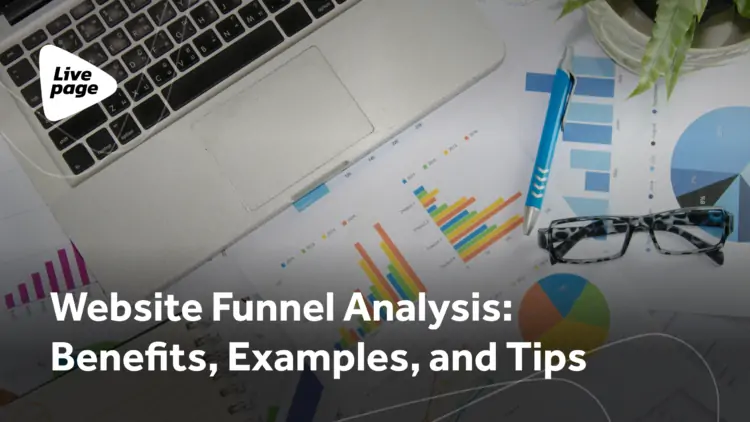
Website Funnel Analysis: Benefits, Examples, and Tips

Would you like to get valuable insights into your user behavior, identify drop-off points in the conversion process, and improve the overall website’s performance? Cool! Because website funnel analysis can assist you with all of that. So, let’s discover what it is and how to use it in detail!
The Importance of Website Funnel Analysis
Effective digital marketing and website optimization are hard to imagine without timely website funnel analysis. But before we talk about the importance of website funnel analysis, we should understand the terminology and definition of what it is.
Website funnel analysis refers to the process of tracking and analyzing the steps visitors take on a website to achieve a specific goal, such as making a purchase, filling out a form, or subscribing to a service.
Funnel analysis is crucial for businesses that rely on their website as a primary source of leads. By conducting funnel analysis, you can identify and address weak points that directly impact revenue, thereby increasing profitability.
The main goal of funnel analysis is to identify and understand the conversion rates and drop-off points at each stage of the user journey, aiming to improve the website’s performance and optimize the conversion process.
What Are the Website Funnel Analysis Benefits?
Take a look at the key advantages of implementing marketing funnel analysis for your site.
Improved Conversion Rates
Website funnel analysis helps businesses identify and rectify areas in the conversion process that may cause visitors to drop off their journey. By understanding the user flow, entrepreneurs can optimize their websites and address any pain points or issues. This optimization can result in higher conversion rates, as visitors will have a smoother experience throughout the conversion path.
Enhanced User Experience
By analyzing user behavior at each stage of the funnel, businesses can identify usability issues, friction points, or confusing elements that may negatively impact the user experience. With this knowledge, they can make informed decisions to streamline the user journey, improve website design and functionality, and ultimately provide a more comfortable experience for visitors.

Targeted Marketing Efforts
Website funnel analysis provides valuable data on the effectiveness of marketing campaigns and channels. By monitoring the performance of varied marketing initiatives throughout the funnel, companies can identify which channels are driving quality traffic and generating leads or conversions. This information enables them to allocate marketing resources more effectively, optimize campaigns, and focus on the channels that deliver the best results.

Decisions Based On Analytics Data
As it was already mentioned, funnel analysis can tell a lot about your website users’ behavior, conversion patterns, and performance metrics. Armed with this information, you can make data-driven decisions to refine your marketing campaigns and the overall work on the website. This, in turn, will increase the effectiveness of your business operations.
To sum up, website funnel analysis offers numerous significant benefits for your business. Incorporating website funnel analysis into your business strategy empowers you to make data-driven decisions, gain valuable lead journey reporting, and optimize marketing strategies. By leveraging these benefits, you can drive growth, increase conversions, and ultimately achieve greater success.
What Are the Most Common Goal-Tracking Issues in Funnel Analysis?
Technical problems can significantly impact the process of funnel analysis, making it more challenging to gather accurate data.
Usually, there are 3 goal tracking issues that can hinder the effectiveness of funnel analysis:
- Incomplete or incorrect goal tracking. Accurate and comprehensive goal tracking is critical because it allows you to measure the effectiveness of your marketing campaigns and website performance. Without proper goal tracking, it becomes difficult to determine which strategies are positively impacting conversions and which need improvement. Improper goal tracking can result in wasted resources on unworkable strategies and missed opportunities to optimize marketing campaigns.
- Lack of segmentation. Understanding user behavior based on segments is vital for adapting marketing strategies and increasing conversion rates. Segmentation groups users according to given characteristics and allows companies to target specific groups of users. Without segmentation, marketing efforts may not be relevant enough and may not resonate with the target audience, resulting in lower conversions and wasted marketing budgets. Other potential consequences of lack of segmentation include lower engagement, lower conversion rates and higher acquisition costs.
- Ignored micro-conversions. Micro-conversions are smaller actions that users take before reaching the ultimate conversion goal, such as subscribing to a newsletter, adding items to a cart, or watching a product demo. Ignoring micro-conversions can prevent a company from understanding the user journey and optimizing conversion funnels.
By tracking and analyzing micro-conversions, companies gain insight into user engagement and can identify areas for improvement. Ignoring such small actions can lead to missed overall opportunities to optimize the user experience and identify potential bottlenecks in the conversion process, which threatens to reduce overall conversion rates.
To overcome these challenges, it’s important to set up goals correctly, verify tracking implementation, test cross-domain tracking, and monitor data consistency. Setting up tracking tools such as Google Analytics ensures that significant conversion events are not missed. However, to set up your analytics correctly and avoid the problems mentioned above, it is better to contact an expert.
How to Do a Website Funnel Analysis?
Starting a website conversion funnel analysis involves a systematic approach. Here are the key steps to get started:
Define Your Conversion Goals
Clearly outline desired actions or conversions on your website, such as:
- purchases,
- add to cart,
- form submissions,
- downloads,
- account registration,
- click-through rates (CTRs),
- or other relevant goals.
Well-defined goals help focus analysis on actions that contribute to your business objectives.
Identify the Stages of Your Funnel
Map out user journey stages on your website, including entry points, landing pages, product/service pages, shopping cart, and checkout. This can be done in any mind map (Miro, FigJam, Freeform, etc.) using the following approach:
- Define your customer personas. Start by identifying and understanding your target audience, and consider the demographics, goals, challenges, motivations, and preferences of each persona.
- Identify touchpoints. These touchpoints can include landing pages, product pages, blog articles, contact forms, shopping carts, and more. Identify both online and offline touchpoints, such as social media, email marketing, or customer support.
- Outline customer journey stages. These stages typically include:
- awareness,
- consideration,
- decision,
- conversion,
- retention,
- advocacy.
- Map touchpoints to customer journey stages. Understanding these stages helps in funnel analytics, tracking user behavior, and identifying potential bottlenecks.

Set Up Tracking Tools
Implement funnel visualization tools, like Google Analytics, to collect data on user interactions and conversions. Ensure correct installation of tracking codes on relevant website pages for capturing necessary data.
Gather Data for Sales Funnel Analysis
Allow some time for tracking tools to gather information over a significant period, better 1 up to 3 months, you need to collect enough data to analyze it and make some decisions. This will help you exclude variations in user behavior and trends, ensuring a robust and representative dataset for analysis.
Segment the Gathered Data
Categorize data based on attributes like traffic sources, device types, demographics, or other relevant factors. This segmentation provides insights into user groups and behavior, enabling tailored marketing strategies and optimized user experiences for each segment.
Identify Optimization Opportunities
Identify areas needing improvement by analyzing user behavior and identifying bottlenecks. This may include enhancing page design, streamlining checkout, improving call-to-action elements, and addressing conversion hindrances.
Implement and Test Optimizations
Make changes to your website or marketing campaigns based on identified opportunities. After, monitor results again and continue testing and refining optimizations to improve conversion rates and overall funnel performance.
The Livepage’s Best Funnel Analysis Examples
As a digital marketing agency, Livepage demonstrates expertise in optimizing funnels for Tech and SaaS, Local, Ecommerce, and other business types. One such company is Yalantis — a leading mobile and web app development company. Our team has set up a marketing funnel for them to achieve growth in search traffic from 0 to 15 000 monthly visitors. There are also successful case studies for other types of businesses, such as Ecommerce analytics solutions.
Generally, our approach to funnel analysis involves conducting comprehensive audits of clients’ marketing and sales processes. This also includes monitoring key metrics and qualitative data to identify areas for improvement. For example, working with the Hoxton Mix, we’ve found “gaps” that required enhancement and created customer journey funnels. Now, there is an increase in their monthly conversions by 172.15% for the entire period of work!
To reach such results, our team uses new-fangled tools and chooses the best solutions.
This process may cover various aspects, like:
- driving targeted traffic;
- improving landing page effectiveness;
- optimizing conversion rates;
- implementing remarketing campaigns;
- enhancing user experience;
- implementing retention and advocacy strategies.
In addition, we provide detailed reports to our clients, keeping them informed about the progress and results of our marketing funnel optimization efforts.
Website Funnel Analysis Tips
To improve the results of your funnel analysis, consider implementing the tips mentioned further. By implementing them, you can enhance your funnel analysis process, gain deeper insights into user behavior, and optimize your website and marketing strategies for long-term success.
Include More Steps
Expand your funnel analysis by including additional steps or micro-conversions leading up to the final conversion goal. By tracking and analyzing these intermediate steps, you can gain insights into user engagement, identify potential drop-off points, and implement targeted optimizations to improve conversion rates.
Measure Conversion Windows
Instead of focusing solely on immediate conversions, consider measuring conversion windows. This involves tracking and analyzing conversions that occur over an extended period. By examining the time it takes for users to convert after their initial interaction, you can better understand the customer journey and optimize your marketing efforts accordingly.
Look at New vs. Returning Visitors
Segment your funnel analysis based on new and returning visitors. New visitors may require different strategies to guide them through the conversion process, while returning visitors may have different expectations or needs. By analyzing the behavior of these two groups separately, you can tailor your approach and optimize the user experience for each segment.
Test One Element at a Time
When optimizing your funnel, it is crucial to test one element at a time. This approach, known as A/B testing or split testing, allows you to isolate and evaluate the impact of specific changes or variations. By testing individual elements, such as headlines, call-to-action buttons, or form fields, you can determine which modifications lead to improved conversion rates and make data-driven decisions.
Use Page Analysis Tools
Utilize page analysis tools, such as heat maps or click tracking, and session recordings to gain deeper insights into user behavior and interactions on specific pages. These tools visually represent user engagement and can highlight areas of high or low interaction. By understanding how users navigate and engage with your pages, you can identify opportunities for optimization and improve the overall user experience.
Gather Feedback
Actively collect feedback from users throughout their journey. Usually, feedback provides valuable insights into user preferences, pain points, and areas where improvements can be made.
Track Progress Over Time
Continuously track and monitor your funnel metrics over time to identify trends and patterns. By analyzing long-term data, you can assess the effectiveness of your optimization efforts and identify areas that may require further attention. Regularly reviewing your funnel metrics allows you to make data-driven decisions and iterate on your strategies for ongoing improvement.
Focus On Retention
While conversions are important, don’t overlook the value of customer retention. Analyze the post-conversion stages of your funnel, such as customer onboarding, engagement, and retention. By focusing on retaining existing customers and fostering long-term relationships, you can maximize customer lifetime value and drive sustainable growth.
To Sum Up
Website funnel analysis refers to the process of tracking and analyzing the steps visitors take on a website to achieve a specific goal, such as making a purchase, filling out a form, or subscribing to a service. The main goal of funnel analysis is to identify and understand the conversion rates and drop-off points at each stage of the user journey, aiming to improve the website’s performance and optimize the conversion process.
Website funnel analysis provides businesses with valuable insights and benefits. By leveraging the power of website funnel analysis, you can make informed optimizations, improve your site’s performance, and drive sustainable growth.
The most common issues in funnel analysis are:
- Incomplete or incorrect goal tracking,
- Lack of segmentation,
- Ignored micro-conversions.
To conduct a quality website funnel analysis, you need to follow these key steps:
- Define your conversion goals,
- Identify the stages of your funnel,
- Set up tracking tools,
- Collect data for funnel analysis,
- Segment the gathered data,
- Identify optimization opportunities,
- Implement and test optimizations.
To get accurate and detailed information about Livepage’s funnel analysis practices, feel free to contact us anytime. Let’s help your online business take off together!



















